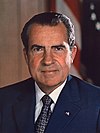Revised Philadelphia Plan
The Revised Philadelphia Plan, often called the Philadelphia Plan, required government contractors in Philadelphia to hire minority workers, under the authority of Executive Order 11246. Declared illegal in 1968, a revised version was successfully defended by the Nixon administration and its allies in Congress against those who saw it as an illegal quota program. US Department of Labor Assistant Secretary for Wage and Labor Standards Arthur Fletcher implemented the plan in 1969 based on an earlier plan developed in 1967 by the Office of Federal Contract Compliance and the Philadelphia Federal Executive Board. The plan required federal contractors to meet certain goals for the hiring of minority employees by specific dates in order to combat institutionalized discrimination on the part of specific skilled building trades unions. The plan was quickly extended to other cities.
In 1971, the Contractors Association of Eastern Pennsylvania challenged the plan and Executive Order 11246 by arguing that it was beyond the President's constitutional authority, that it was inconsistent with Titles VI and VII of the Civil Rights Act of 1964 and that it was inconsistent with the National Labor Relations Act. The United States Court of Appeals for the Third Circuit rejected the challenges[why?] and the US Supreme Court declined to hear the case, Contractors Association of Eastern Pennsylvania v. Secretary of Labor, in October.
See also
References
- ^ "Philadelphia Plan | Encyclopedia.com". www.encyclopedia.com. Retrieved December 5, 2018.
- ^ "The Philadelphia Plan (1967-) | The Black Past: Remembered and Reclaimed". blackpast.org. Retrieved December 5, 2018.
- ^ Anderson, Terry H. (2004). The Pursuit of Fairness: A History of Affirmative Action. Oxford University Press. pp. 126–7.
- ^ Janson, Donald (April 24, 1971). "Minority Hiring Upheld by Court" (PDF). New York Times. Retrieved February 9, 2014.
- ^ Contractors Association of Eastern Pennsylvania v. Secretary of Labor, 442 F.2d 159 (3rd Cir.), cert. denied, 404 U.S. 854 (1971). From Google Scholar. Retrieved on February 8, 2014.
- ^ Golland, David Hamilton (2011). Constructing Affirmative Action: The Struggle for Equal Employment Opportunity. University Press of Kentucky. ISBN 978-0813139647.

